The Essential Guide to Christmas Traditions
Christmas, a time of joy, warmth, and togetherness, is celebrated with fervor and enthusiasm worldwide. Among the best Christmas traditions, the mesmerizing glow of Christmas lights illuminating homes and streets stands out, casting a magical spell on onlookers. These twinkling lights, often symbolic of hope and happiness, are a cornerstone of the festive season, evoking cherished memories and creating new ones.

Behind the Festive Magic
For many, family Christmas gatherings are the heart and soul of the holiday. Families come together, sometimes traveling great distances, to relive and create traditions that have been passed down through generations. These classic Christmas traditions range from sharing meals and singing carols, to exchanging gifts, each with its own unique story and significance. The essence of these practices lies not just in their observance but in the bonds they strengthen and the love they spread.
Over the years, holiday traditions have evolved, with some becoming more popular as they resonate with the changing times. These popular Christmas customs, whether it’s the act of hanging stockings or setting up an advent calendar, have a way of instilling a sense of wonder and anticipation. Each country, each community, and even each family might have its own unique Christmas customs that set their celebrations apart, yet the underlying spirit remains universal.
As we explore the myriad traditions and customs associated with this beloved holiday, we’ll discover the rich tapestry of stories, beliefs, and practices that make Christmas a truly enchanting time of the year.
Historical Traditions:
The celebration of Christmas is deeply rooted in history, blending religious observances with ancient customs. This rich tapestry of traditions has evolved over millennia, influenced by diverse cultures and historical events. Let’s delve into the origins and evolution of these cherished customs.
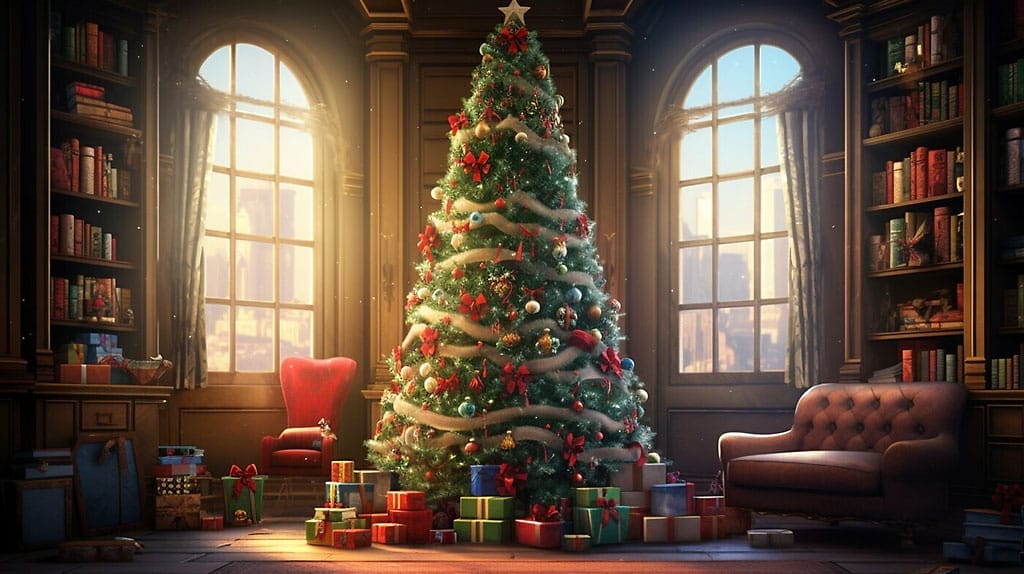
- The Birth of Jesus Christ: Central to Christmas is the commemoration of the birth of Jesus Christ in Bethlehem. Celebrated by Christians worldwide, this event signifies the foundation of the Christian faith. The nativity scenes, often displayed prominently during the season, symbolize this sacred event. The story of the Star of Bethlehem, the Three Wise Men, and the humble manger are integral to this tradition.
- Pagan Festivals and Their Influence: Long before Christmas was celebrated, various pagan festivals took place during the winter solstice. Festivals such as Saturnalia in Rome and Yule in Northern Europe celebrated the return of longer days. Many customs, like decorating with evergreens, have roots in these ancient celebrations, symbolizing life during the cold winter months.
- Evolution of Christmas Over the Centuries: As centuries passed, Christmas underwent numerous transformations. Different eras and cultures added their unique touch, from medieval feasts to Old English Victorian traditions. Today’s Christmas is a culmination of these varied influences, creating a global celebration with diverse local flavors.
- St. Nicholas and the Origin of Santa Claus: The beloved figure of Santa Claus traces back to St. Nicholas of Myra, a 4th-century bishop renowned for his generosity. Stories of his kindness, combined with other legends and folklore, gradually shaped the image of the jolly, gift-giving Santa we recognize today.
- The Twelve Days of Christmas: This tradition spans the days between Christmas and the Epiphany on January 6th. Originating from the East, each day holds its own significance, marked by specific celebrations, feasts, and sometimes, specific gifts. It culminates in the celebration of the Three Wise Men’s visit to baby Jesus.
- Christmas Bans and the Puritan Influence: In the 17th century, Puritans, both in England and parts of America, prohibited Christmas festivities, deeming them remnants of pagan traditions. This ban lasted for years in certain regions, and the reinstatement of Christmas as a public holiday marked a significant cultural shift.
- Origin of Christmas Cards: The tradition of sending Christmas greetings began in Victorian England. Sir Henry Cole and artist John Horsley are credited with creating the first commercial card in 1843. This gesture of goodwill during the festive season rapidly gained popularity and has since become a staple of the holiday.
- The Advent Calendar: This countdown to Christmas, which starts on December 1st, has its roots in 19th-century Germany. Originally, days were marked off with chalk. Today, these calendars range from simple paper designs to elaborate creations with daily treats or gifts.
Decorative Traditions:
Christmas decorations are more than just festive adornments; they’re symbols of joy, hope, and the spirit of the season. Each ornament and light tells a story, rooted in history and tradition. Let’s delve into the captivating world of Christmas decorative traditions.
- The Christmas Tree The Christmas tree, often an evergreen conifer, stands as a symbol of everlasting life. Originating from Germany in the 16th century, it was adorned with candles, which were eventually replaced by lights. Today, families around the world decorate their trees with ornaments, tinsel, and stars, making it the centerpiece of Christmas celebrations.
- Ornaments and Their Meanings Ornaments have evolved from simple homemade items to intricate designs. In bygone days, a Christmas ornament was made of fruits, nuts, or paper, symbolizing prosperity and hope. Over time, artisans began crafting glass and metal ornaments, each with its own significance. For instance, an angel represents God’s guidance, while a star signifies the Star of Bethlehem.
- Festive Lights, Wreaths, and Candles Lights have always been integral to Christmas. Originally, candles illuminated homes, representing Christ as the light of the world. This evolved into the use of electric lights, brightening streets and homes. Wreaths, circular in shape, symbolize eternity and the unending love of God. They’re often hung on doors, welcoming all with festive cheer.
- Nativity Scenes (or Crèches) These are artistic depictions of the birth of Jesus Christ, showcasing figures like Mary, Joseph, the baby Jesus, shepherds, the Three Wise Men, and animals. Originating in Italy, nativity scenes are now displayed worldwide, both indoors and outdoors, during the Christmas season.
- Mistletoe and Holly Mistletoe is often hung in homes, and it’s a tradition for people to kiss underneath it. This plant, considered a symbol of love and friendship, has Celtic and Norse origins. Holly, with its sharp leaves and red berries, represents the crown of thorns worn by Jesus and the blood he shed, making it a significant decorative symbol.
- Christmas Stockings Hung by the fireplace, stockings await small gifts from Santa Claus. This tradition has roots in the legend of St. Nicholas, who is said to have dropped gold coins down the chimney of a poor man, which landed in stockings drying by the fire.
- Tinsel and Garlands Tinsel, originally made from silver, is draped on trees to represent sparkling ice. Garlands, made from various materials like popcorn, beads, or pinecones, are used to decorate trees, mantels, and staircases, adding a festive touch.
- Advent Calendars and Wreaths Advent calendars count down the days to Christmas, starting from December 1st. Each day has a small door or pocket revealing a treat or image. Advent wreaths, with four candles, mark the four weeks leading up to Christmas. One candle is lit each Sunday, symbolizing anticipation and hope.
Culinary Tradition:
Christmas celebrated with fervor worldwide, is a symphony of flavors and aromas that evoke nostalgia and warmth. From sipping hot chocolate by the fireplace to building gingerbread houses with family, the season is replete with a culinary Christmas feast. Each region boasts its unique dishes and treats, reflecting its culture, history, and heart. Let’s embark on a gastronomic journey, exploring some of the most cherished Christmas culinary traditions from around the globe.
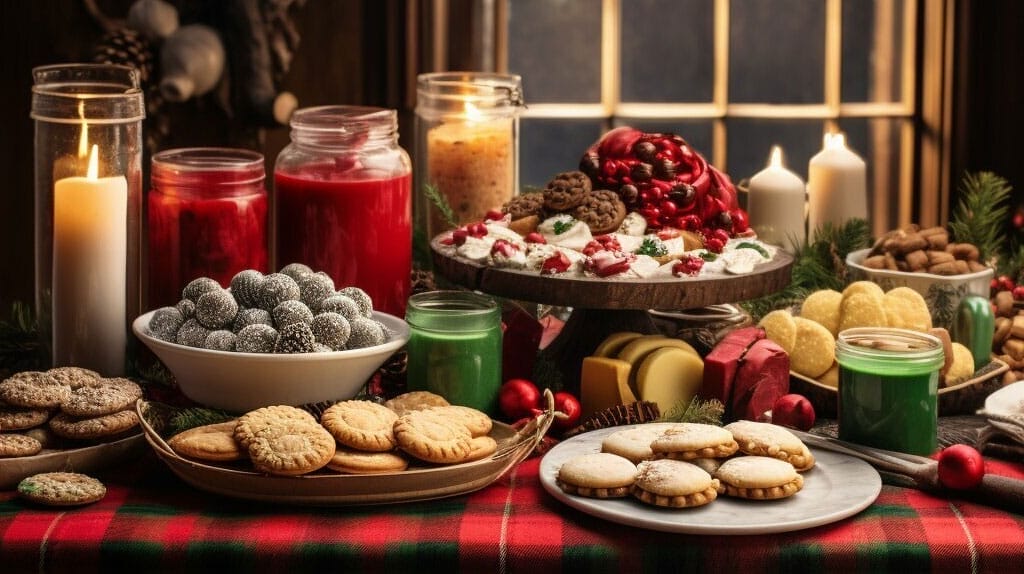
- Traditional Christmas Dishes From the roasted turkey in the United States, accompanied by a side of Christmas cookies, to the almond-rich ‘turrón’ in Spain, every region has its signature dish. The British Christmas pudding, a rich, fruity treat, has been a staple since medieval times often enjoyed after a hearty meal. These dishes, paired with candy canes or a glass of milk and cookies for Santa, are more than just food; they’re a celebration of heritage and festive spirit.
- Christmas Pudding and Mince Pies Originating from the UK, Christmas pudding is a dense, spiced fruit cake, often flambéed before serving, creating a spectacle at the dinner table. Mince pies, delightful small pastries, are filled with a mixture of dried fruits and spices called “mincemeat”. Paired with a warm cup of hot chocolate, both these treats have become synonymous with British Christmas celebrations.
- Beverages: Eggnog, Mulled Wine, and Hot Cocoa Drinks play a pivotal role in festive celebrations. Eggnog, a creamy concoction made with milk, sugar, and eggs, is a North American favorite, often spiked with a dash of rum or brandy. Mulled wine, spiced and heated, warms the soul in many European countries, perfect for chilly evenings. And then there’s hot cocoa, a universal favorite, topped with marshmallows and enjoyed alongside Christmas cookies, bringing comfort and joy on cold winter nights.
- Panettone and Pandoro Italy’s sweet contribution to Christmas is the aromatic bread loaves of Panettone and Pandoro. Panettone, studded with candied fruits and raisins, hails from Milan and is often enjoyed with a side of gingerbread house-making. Pandoro, a golden bread from Verona, is sprinkled with powdered sugar, resembling snowy peaks, and is a perfect accompaniment to sweet wine or liqueur.
- Tamales In Latin American celebrations, tamales stand out. These are steamed corn dough (masa) parcels filled with meats, cheeses, or chilies, wrapped in corn husks. The making of tamales is a communal event, with families gathering for a delightful tradition called “tamalada”, often followed by sharing stories over hot chocolate.
- Stollen Germany’s Stollen is a fruit bread, rich with nuts, spices, and dried or candied fruit. Its unique shape symbolizes the baby Jesus in swaddling clothes. Paired with tea or coffee, and perhaps a side of Christmas cookies, it’s a festive treat that embodies the spirit of the season.
- Bûche de Noël The Bûche de Noël, or Yule Log, is a French masterpiece. This sponge cake is rolled, filled with cream, and covered in chocolate, resembling a log. It celebrates the ancient tradition of burning the Yule log during Christmas and is often the centerpiece of dessert tables, surrounded by candy canes and other festive treats.
- Feast of the Seven Fishes An Italian-American tradition, this feast involves preparing seven different seafood dishes on Christmas Eve. Each fish dish represents a day of biblical creation, and the entire meal is a commemoration of the wait for the midnight birth of Jesus. It’s a culinary journey, often punctuated with stories and laughter.
- Kutia In Ukraine, Kutia is a cherished dish. This sweet grain pudding, made from wheat berries, poppy seeds, honey, and nuts, marks the beginning of the Ukrainian Christmas Eve supper. Symbolizing hope and harvest, it’s a dish that connects generations and is a testament to the country’s rich culinary heritage.
Gift-Giving Traditions:
Gift-giving during Christmas is a heartfelt gesture that embodies love, generosity, and the festive spirit. This tradition, with roots in ancient tales and customs, has evolved over time, reflecting the cultural richness of societies worldwide. Let’s delve deeper into the myriad gift-giving traditions that have shaped our Christmas celebrations.

- The Legend of Saint Nicholas Saint Nicholas, a revered figure from the 3rd century, is often credited as the original Santa Claus. Born in Myra, present-day Turkey, he became legendary for his acts of kindness. One particularly famous tale narrates how he secretly gifted gold to three impoverished sisters, saving them from dire straits. This act of discreet generosity laid the groundwork for the tradition of secret gift-giving, a practice that resonates even today. Discover more about Saint Nicholas.
- Evolution of Santa Claus The modern-day Santa Claus is a delightful amalgamation of various legends, most notably Saint Nicholas and Britain’s Father Christmas. Over centuries, this jolly, red-suited figure has become synonymous with Christmas Eve. Children from diverse cultures eagerly await his visit, hoping to find a trove of presents, a testament to the universal appeal of this enchanting tradition.
- Stockings by the Fireplace The charming custom of hanging stockings by the fireplace has its roots in a tale involving Saint Nicholas. Legend has it that he dropped gold coins down a chimney, which serendipitously landed in stockings drying by the fire. Today, this tradition is celebrated by families worldwide, with children eagerly checking their stockings for gifts and treats on Christmas morning.
- Advent Calendars The advent calendar, a cherished tradition that originated in 19th-century Germany, serves as a delightful countdown to Christmas. Each day, a window is opened to reveal a treat or a small gift, building anticipation for the festive day. This daily ritual, often accompanied by a short story or verse, adds a touch of magic to the season’s preparations.
- The Christmas Shoe In various European regions, children follow the enchanting tradition of leaving shoes or boots out on Christmas Eve. As dawn breaks, they rush to find them brimming with treats or small gifts. This custom, reminiscent of the stocking tradition, showcases the diverse and imaginative ways cultures celebrate the spirit of giving.
- Three Kings’ Day Gifts Three Kings’ Day, or Epiphany, celebrated predominantly in Spain and Latin America, commemorates the three wise men’s arrival bearing gifts for baby Jesus. On January 6th, children often wake up to presents, symbolizing the gifts of gold, frankincense, and myrrh, extending the festive gift-giving spirit into the New Year.
- Yule Lads of Iceland Iceland boasts a unique Christmas tradition involving the 13 Yule Lads. These mischievous troll-like figures visit children for 13 nights leading up to Christmas. Depending on whether the child has been naughty or nice, they either receive delightful gifts or playful tricks in their shoes, adding a touch of whimsy to the festive season.
- Italy’s La Befana In Italy, children eagerly await La Befana, a kind-hearted witch who delivers gifts on Epiphany’s eve. Gliding on a broomstick, she fills stockings with candies for well-behaved children and coal for those who’ve been mischievous. This tradition, echoing the Santa Claus narrative, adds a unique Italian flair to Christmas celebrations.
- Julklapp of Scandinavia Scandinavia celebrates “Julklapp,” a playful gift-giving custom. It involves knocking on doors, swiftly throwing in wrapped gifts, and making a hasty retreat. The recipient is then left with the delightful task of unwrapping the surprise, adding an element of fun and mystery to the Yuletide festivities.
Musical Traditions:
Music has always been the heartbeat of Christmas, echoing the joy, reverence, and festivity of the season. From ancient hymns to contemporary carols, musical traditions have evolved, yet they remain deeply rooted in the spirit of Christmas. Let’s embark on a melodious journey, exploring the rich tapestry of musical customs that have graced our Yuletide celebrations.
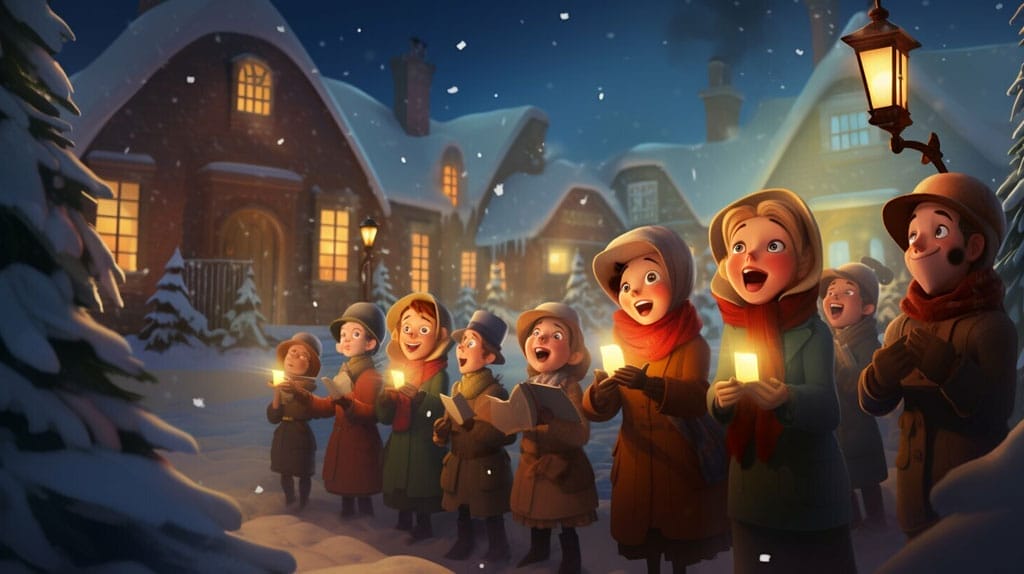
- Origins of Christmas Carols Christmas carols, with their harmonious melodies and uplifting lyrics, trace their origins back to medieval Europe. Initially, these were not exclusive to Christmas and were performed during all major celebrations. However, by the 13th century, carols associated with the nativity story began to gain prominence. These early carols, sung in local languages, resonated deeply with the masses, setting the stage for a cherished Christmas tradition. Learn more about the history of carols.
- Modern Christmas Songs The 20th century witnessed the emergence of contemporary Christmas songs, capturing the essence of the festive season in a modern context. Classics like “White Christmas”, “Jingle Bell Rock” and “Merry Christmas” have become seasonal staples, played in homes, malls, and on radio stations worldwide. These songs, while relatively new, have seamlessly woven themselves into the fabric of Christmas celebrations, highlighting the timeless appeal of festive music.
- Role of Music in Festive Celebrations Music plays an indispensable role in Christmas festivities. From church choirs singing hymns during Midnight Mass to families gathering around the piano to sing carols, music amplifies the joy of the season. In many cultures, caroling groups visit homes, sharing melodies and spreading cheer. This communal aspect of music, where voices unite in celebration, embodies the true spirit of Christmas.
- Instrumental Traditions Beyond vocal music, instruments have their own place in Christmas traditions. The gentle chimes of bells, the deep tones of the organ, and the lively beats of drums enhance the festive atmosphere. In some cultures, specific instruments like the zither in Austria or the bagpipes in Scotland play traditional Christmas tunes, adding a unique sonic signature to the celebrations.
- Christmas Operas and Ballets The world of classical music has contributed immensely to Christmas celebrations. Operas like Gian Carlo Menotti’s “Amahl and the Night Visitors” and ballets like Tchaikovsky’s “The Nutcracker” have become seasonal favorites. These grand productions, with their intricate compositions and captivating narratives, offer a mesmerizing musical experience, enriching the festive arts scene.
- Global Musical Traditions Around the world, diverse cultures have their own musical interpretations of Christmas. From the lively “Parrandas” in Puerto Rico to the serene “Stille Nacht” (Silent Night) in Austria, each tradition reflects its own cultural nuances. These global melodies, while varied in style and language, converge in their celebration of the universal themes of love, hope, and joy.
- Music as a Gift Music, in its essence, is a gift. Many families and friends exchange mixtapes or playlists of their favorite Christmas songs, creating personalized soundtracks for the season. This tradition, while modern, underscores the timeless sentiment that music is a gift that keeps on giving, touching souls and creating cherished memories.
- Digital Era and Christmas Music The digital age has transformed how we consume music. Streaming platforms curate festive playlists, and artists release digital Christmas albums, making it easier than ever to access and share holiday tunes. This digital evolution, while changing the medium, has only amplified the enduring charm of Christmas music, ensuring its legacy for generations to come.
Global Traditions:
Christmas, while universally celebrated, takes on unique hues and flavors as it travels across continents. Each region, with its cultural nuances and historical narratives, offers a distinct interpretation of holiday cheer during the festive season. From the snowy landscapes of Europe to the sunny shores of Oceania, let’s embark on a journey to discover the diverse Christmas traditions that enrich our global tapestry.
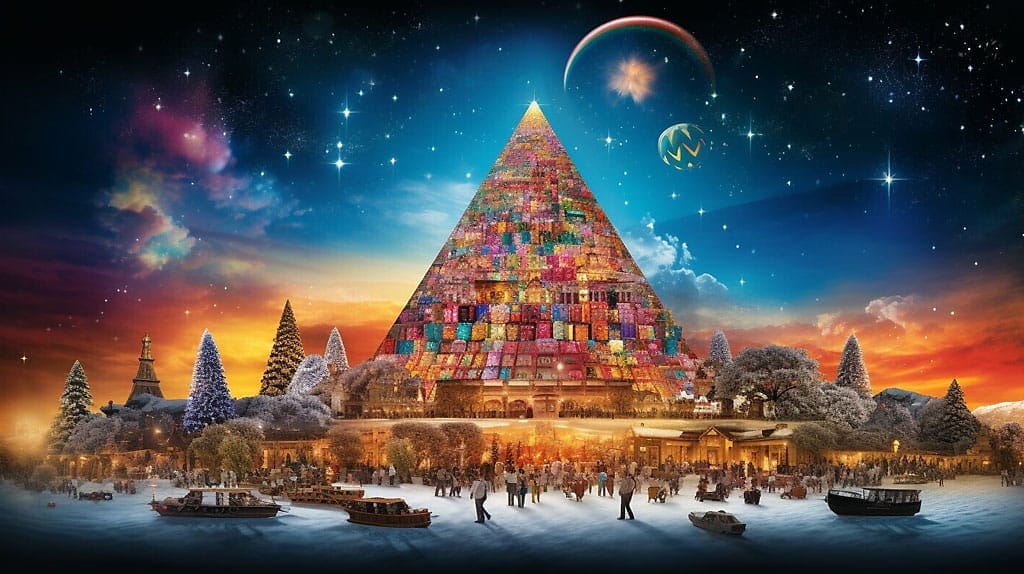
- European Festivities Europe, with its rich history and myriad cultures, boasts a plethora of Christmas traditions. In Northern Europe, the celebration of the Winter Solstice blends seamlessly with Christmas, resulting in a fusion of customs like the Yule log and festive bonfires. Central Europe, with its enchanting Christmas markets, fills the air with the aroma of mulled wine and gingerbread. Meanwhile, Eastern Europe, with its Orthodox Christian roots, often celebrates Christmas in January, accompanied by unique rituals and feasts.
- North and South American Celebrations The Americas, a melting pot of cultures, offer a vibrant Christmas tapestry. North America, influenced by European settlers, has popularized customs like caroling and the iconic Christmas tree. In contrast, South America, with its Spanish and Portuguese influences, celebrates with grand processions like Las Posadas in Mexico and vibrant nativity scenes, or “pesebres”, in countries like Brazil and Argentina.
- African Joy and Reverence Africa, a continent of diverse tribes and languages, celebrates Christmas with a blend of reverence and festivity. While the religious aspect is predominant, with church services and nativity plays, there’s also a focus on community gatherings, music, and dance. Countries with a significant Christian population, such as Nigeria and Ethiopia, see grand feasts and parades, making Christmas a communal and spirited affair.
- Asian Confluence of Traditions Asia, with its vast cultural landscape, has embraced Christmas, blending it with local customs. The Philippines, with its Christian majority, starts the festive season as early as September, culminating in the “Simbang Gabi” or night masses. In contrast, countries like Japan and South Korea, where Christmas is not a public holiday, have adopted it as a time for gift-giving and romantic dates, showcasing the fusion of Western and Eastern traditions.
- Oceania’s Sunny Celebrations Oceania, comprising Australia, New Zealand, and the Pacific Islands, offers a sun-drenched Christmas experience. While Australia and New Zealand have adopted many Western customs, they’ve also added a twist with beach barbecues and summer feasts. The Pacific Islands, with their communal cultures, emphasize church services, choir performances, and grand feasts, making Christmas a time of togetherness and joy.
Religious Traditions:
Religious observances during Christmas provide a profound connection to the spiritual essence of the holiday. These traditions, deeply rooted in Christian teachings and practices, offer a moment of reflection, gratitude, and communion with the divine. As we explore these religious customs, we gain insight into the sacred celebrations that have shaped the way countless believers honor the birth of Jesus Christ.
- The Advent Season Advent, derived from the Latin word “adventus” meaning “coming,” is a period of preparation and anticipation leading up to Christmas. Beginning on the fourth Sunday before Christmas, believers light candles, read scriptures, and engage in prayer, reflecting on the profound mystery of the Incarnation. Advent calendars, with their daily treats or verses, have become a popular way to mark this spiritual journey, culminating in the joyous celebration of Christ’s birth.
- Midnight Mass Midnight Mass is a quintessential Christmas Eve tradition for many Christians worldwide. As the clock strikes midnight, signifying the onset of Christmas Day, believers gather in churches to commemorate the birth of Jesus. This solemn and joyous ceremony, replete with hymns, scriptures, and the Eucharist, serves as a poignant reminder of the spiritual significance of Christmas.
- The Twelve Days of Christmas Contrary to popular belief, the Twelve Days of Christmas aren’t a countdown to December 25th but a celebration that begins on Christmas Day and ends on Epiphany, January 6th. Each day holds specific religious significance, with feasts and observances honoring various saints and biblical events. From St. Stephen’s Day to the Feast of the Holy Name, these twelve days offer a continued reflection on the Christmas narrative.
- Epiphany and the Three Wise Men Epiphany celebrated on January 6th, marks the visitation of the Magi, or the three wise men, to baby Jesus. Bearing gifts of gold, frankincense, and myrrh, their journey symbolizes the revelation of Christ to the Gentiles. In many cultures, Epiphany is a significant religious event, with processions, feasts, and special church services. It’s a day to reflect on the universal message of love and salvation brought by Jesus.
- Nativity Scenes and Pageants Nativity scenes, depicting the birth of Jesus in a stable in Bethlehem, are a cherished Christmas tradition. These tableau representations, featuring figures of Mary, Joseph, baby Jesus, shepherds, and the Magi, serve as visual reminders of the humble and miraculous circumstances of Christ’s birth. Many churches and communities also organize nativity pageants, where the Christmas story is enacted, bringing the biblical narrative to life.
- Feast of St. Stephen Celebrated on December 26th, the Feast of St. Stephen honors the first Christian martyr. Known for his charitable acts and deep faith, Stephen’s story is a testament to unwavering devotion. In some cultures, this day is also associated with acts of kindness and charity, reflecting St. Stephen’s legacy of compassion.
- Candlelit Processions In various parts of the world, candlelit processions are organized during the Christmas season. Participants, holding candles, walk through streets singing hymns and carols. These processions, illuminating the dark winter nights, symbolize the light of Christ dispelling the darkness of sin and despair.
- Feast of the Holy Innocents Observed on December 28th, this day commemorates the massacre of male infants in Bethlehem by King Herod, as he sought to eliminate the newborn “King of the Jews.” It’s a somber reflection on the sacrifices made and the challenges faced in the early days of Christianity.
Modern Christmas Traditions:
In today’s fast-paced world, Christmas remains a beacon of joy, warmth, and togetherness. While many age-old traditions continue to be celebrated, new customs have emerged, reflecting contemporary lifestyles and the influence of technology. These modern traditions, though recent, have quickly found a place in the hearts of many, becoming integral to the festive celebrations. Let’s explore some of the most popular modern Christmas traditions that resonate with today’s generation.
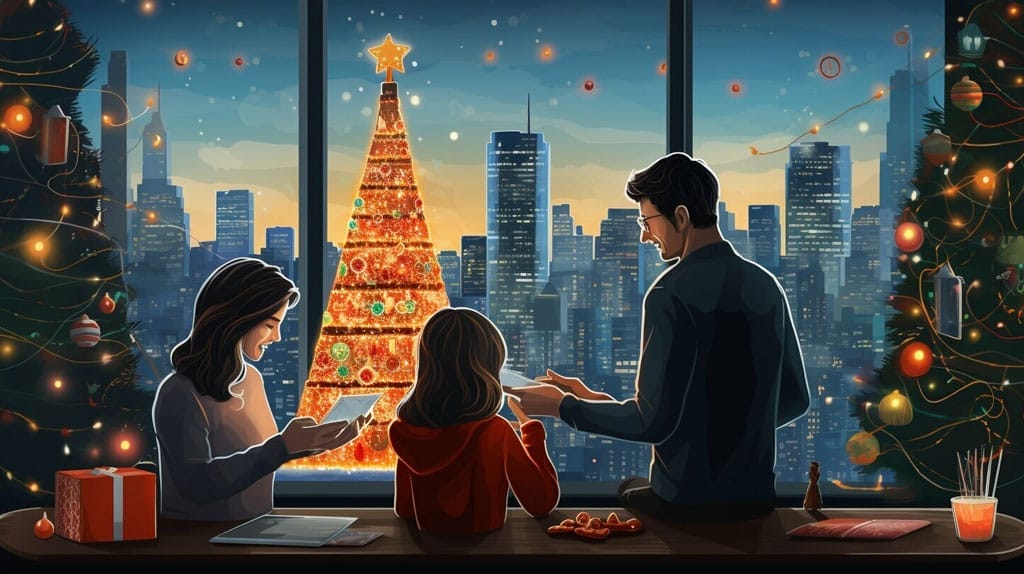
- Ugly Christmas Sweater Parties Donning an “Ugly Christmas Sweater” has become a fun and quirky tradition. What began as a lighthearted jest on old-fashioned holiday wear has transformed into themed parties where attendees compete to wear the most outlandish or humorous Christmas sweater. These gatherings, filled with laughter and camaraderie, have become a festive staple in many households, adding a touch of playful jest to the season. Find your Ugly Christmas Sweater here!
- Digital Advent Calendars The traditional advent calendar has received a digital makeover. Many websites and apps now offer digital advent calendars, where users can click on a date to reveal a virtual treat, message, or even a charitable act to perform. This modern twist combines the age-old anticipation of Christmas with the conveniences of technology.
- Secret Santa Online The beloved tradition of Secret Santa, where participants anonymously exchange gifts, has moved online. Websites and apps facilitate the random assignment of participants, wish list creation, and even the purchase and delivery of gifts. This digital adaptation ensures that even those separated by distance can partake in the joy of surprise gift-giving.
- Christmas Movie Marathons With the advent of streaming platforms, binge-watching Christmas movies has become a cherished tradition. Families and friends gather to watch classics and new releases, immersing themselves in festive tales of love, hope, and magic. From heartwarming stories to holiday rom-coms, these movie marathons encapsulate the spirit of the season.
- Eco-Friendly Celebrations As environmental awareness grows, many have embraced eco-friendly Christmas traditions. From sustainable gift wrapping using cloth or recycled paper to opting for locally sourced and organic festive meals, these green practices reflect a conscious effort to celebrate responsibly.
- Virtual Christmas Gatherings With advancements in technology and recent global events, virtual Christmas gatherings have gained popularity. Families and friends separated by miles connect via video calls, sharing festive moments, and meals, and even opening gifts together in real time, proving that distance is no barrier to heartwarming celebrations.
- DIY Craft and Decor Workshops The DIY trend has taken Christmas by storm. Many indulge in workshops that teach crafting personalized ornaments, homemade candles, and unique decorations. These hands-on experiences not only result in bespoke festive decor but also offer the joy of creation.
- Elf on the Shelf: A Playful Watcher A recent addition to Christmas celebrations is the “Elf on the Shelf.” This mischievous little character is said to keep an eye on children’s behavior during the festive season, reporting back to Santa. Many families have embraced this playful tradition, setting up the elf in various spots around the house each day. It’s not just for kids, though. Friends and family members often join in the fun, sharing photos and stories of the elf’s daily antics and adventures, making it a delightful way to bond and share laughter during the holidays.
Recreational Traditions:
Christmas isn’t just about the solemnity of religious observance or the joy of gift-giving; it’s also a time for fun, games, and merriment. Across the globe, communities have developed recreational traditions that add a layer of excitement and playfulness to the festive season. These customs, often passed down through generations, bring families and friends together in shared moments of joy and laughter. Let’s explore some of these delightful Christmas activities that make Christmas truly unforgettable.
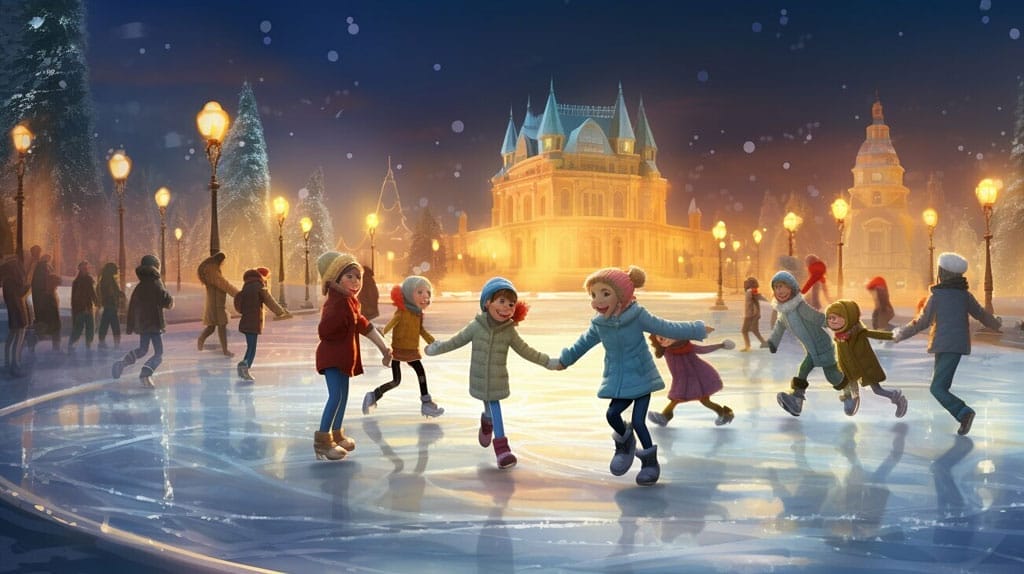
- Christmas Crackers A staple at many Christmas dinner tables, especially in the UK, the Christmas cracker is a festive novelty. Two people pull apart this brightly decorated paper tube, resulting in a small bang. Inside, one finds a paper crown, a joke, and a small gift or toy. The tradition, dating back to the 19th century, adds a touch of fun and surprise to Christmas meals, with everyone donning paper crowns and sharing jokes.
- Mistletoe Traditions The hanging of mistletoe is a romantic custom celebrated in many Western cultures. Legend has it that standing beneath this plant invites a kiss, turning it into a symbol of love and friendship. This age-old tradition, rooted in Norse mythology, adds a touch of romance to the festive season, with many eagerly awaiting that special mistletoe moment.
- Christmas Parades From the Macy’s Thanksgiving Day Parade in the U.S. to the Toronto Santa Claus Parade in Canada, festive processions mark the beginning of the holiday season. These grand parades, featuring floats, bands, and a grand finale with Santa Claus, draw thousands of spectators. It’s a spectacle of joy, creativity, and community spirit, ushering in the Christmas mood.
- Outdoor Activities In regions blessed with snow, Christmas is incomplete without outdoor fun. Building snowmen, engaging in snowball fights, and sledding down snowy slopes are cherished activities. For others, it might be a festive walk in the park or a visit to a beautifully lit town square, making the most of the wintry atmosphere.
- Carol Singing Caroling is a heartwarming tradition where groups, often families or friends, go from house to house singing Christmas carols. This melodious custom, which began in Europe, spreads cheer and the spirit of the season. Whether performed in neighborhoods, churches, or town centers, caroling brings communities together in song and celebration.
- Secret Santa and White Elephant These playful gift exchange games are popular in workplaces and among friends. In Secret Santa, participants draw names to determine who they’ll anonymously gift, while White Elephant involves quirky and often humorous gift exchanges. Both traditions add an element of surprise and camaraderie to Christmas gatherings.
- Nativity Plays Many Christian communities and schools perform nativity plays, reenacting the birth of Jesus Christ. Children often take on roles like Mary, Joseph, the Three Wise Men, and shepherds. These plays, rich in symbolism and meaning, serve as a reminder of the religious significance of Christmas while allowing participants to engage in theatrical expression.
Traditions of Togetherness:
Christmas, at its core, is a celebration of togetherness, love, and community. Across the globe, families, friends, and communities come together, reinforcing bonds and creating cherished memories. These traditions, whether ancient or modern, emphasize the importance of unity and the joy of shared experiences. Let’s explore some of the most heartwarming traditions that bring people closer during this festive season.
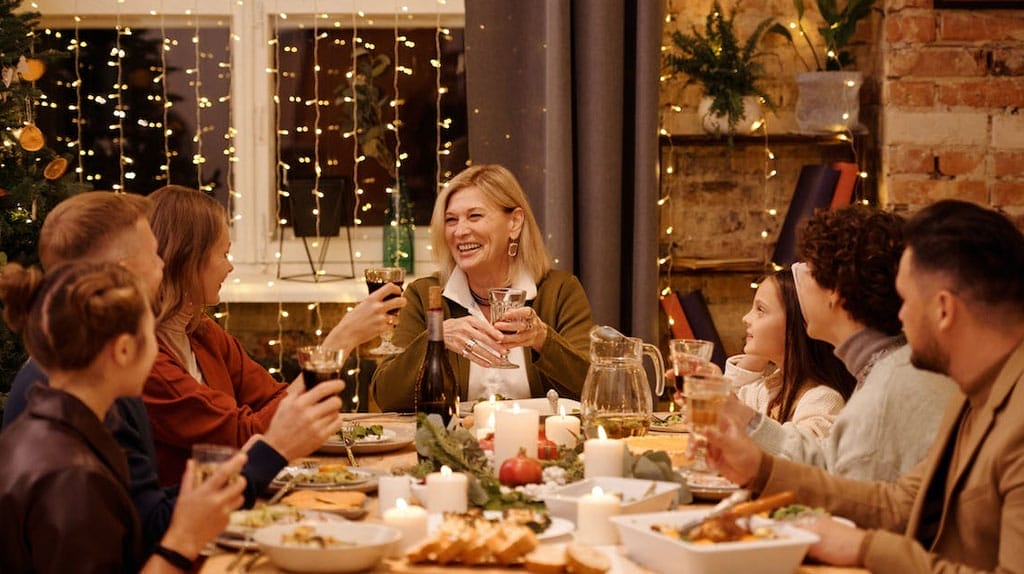
- Family Gatherings The tradition of family gatherings is the cornerstone of Christmas celebrations. Homes bustle with activity as families reunite, often traveling great distances to be together. The festive table, laden with delicacies, becomes a place of laughter, storytelling, and shared gratitude. These gatherings, transcending generations, are a testament to the enduring importance of family ties during the festive season.
- Caroling and Sing-Alongs Caroling is a delightful tradition where groups, often families or friends, go from house to house singing Christmas carols. This melodious practice, dating back to medieval times, spreads cheer and the spirit of the season. Modern variations include sing-along sessions, where families gather around a piano or a music system, belting out their favorite Christmas tunes, and creating harmonious memories.
- Community Feasts In many cultures, communities come together to organize grand feasts, ensuring that everyone, irrespective of their social or economic status, partakes in the festive bounty. These communal meals, often organized by churches or local groups, embody the spirit of sharing and emphasize the idea that joy multiplies when divided.
- Midnight Church Services For many, attending a midnight church service is a cherished Christmas Eve tradition. The serene ambiance, lit candles, and hymns create a spiritual atmosphere, allowing attendees to reflect on the year gone by and pray for the future. This communal act of worship strengthens community bonds and sets a contemplative tone for the celebrations.
- Exchange of Greetings The exchange of holiday cards, from classic designs to those inspired by favorites like “Charlie Brown Christmas,” is a cherished tradition that bridges distances. Even in our digital age, the joy of receiving a handwritten card remains unparalleled. This heartfelt gesture, filled with Christmas cheer, conveys wishes and blessings. It not only reinforces connections but also spreads warmth and goodwill during the festive season.
- Neighborhood Decorations Neighborhoods transform into wonderlands with coordinated decoration efforts. Streets lined with twinkling lights, houses adorned with ornaments, and community Christmas trees create a visual spectacle. This collective endeavor not only enhances the festive ambiance but also fosters a sense of community pride and unity.
- Charity and Acts of Kindness Christmas is often marked by acts of charity, with individuals and communities reaching out to the less fortunate. Be it donating to food banks, gifting warm clothes, or volunteering at shelters, these acts of kindness embody the true spirit of Christmas, emphasizing love, compassion, and the joy of giving.
- Traditional Games and Storytelling Post the festive meal, families often engage in traditional games, quizzes, or storytelling sessions. These activities, passed down through generations, offer a fun-filled way to bond. From sharing ancestral tales to playing board games, these moments of togetherness create memories that last a lifetime.
Craft and DIY Traditions:
Crafting during the festive season is more than just a creative outlet; it’s a way to bond with loved ones, create lasting memories, and add a personal touch to the celebrations. From handmade cards to intricate ornaments, DIY Christmas crafts have been passed down through generations, reflecting the essence of the holiday spirit. Let’s explore some of the most cherished craft and DIY traditions that have adorned our Christmases over the years.
- Handmade Christmas Cards Before the digital age, handmade Christmas cards were the norm. Crafted with love and care, these cards often featured intricate designs, sketches, and heartfelt messages. Families would gather around the table, armed with colored paper, glitter, and paints, creating personalized cards for friends and relatives. This tradition not only fostered creativity but also emphasized the personal touch in conveying festive wishes. Today, many still cherish the art of making and receiving handmade cards, considering their treasured keepsakes.
- Crafting Ornaments Decorating the Christmas tree is a beloved tradition, made even more special with handmade ornaments. From paper stars and beaded snowflakes to clay figurines and fabric angels, these ornaments often carry stories of their own. Families pass down crafting techniques, ensuring that each generation adds its unique touch to the tree. These ornaments, brimming with history and sentiment, become heirlooms, symbolizing the continuity of family traditions.
- DIY Wreaths and Nativity Scenes Wreaths, symbolizing eternal life, have adorned doors for centuries. Crafting a personalized wreath using evergreens, ribbons, and baubles adds a unique touch to the festive decor. Similarly, creating a nativity scene, or “crèche,” is a cherished tradition in many cultures. Families come together to depict the birth of Jesus, using clay, wood, or fabric, adding their interpretations and styles to this iconic representation.
- Homemade Advent Calendars The advent calendar, counting down to Christmas, takes on a special meaning when made at home. Families craft boxes, pouches, or pockets, filling them with treats, trinkets, or notes. Each day’s reveal becomes a cherished moment, made even more memorable by the handmade touch. This DIY tradition fosters anticipation and adds a layer of personalization to the festive countdown.
- Handcrafted Gifts In an era of commercialization, handcrafted gifts stand out for their thoughtfulness and effort. Be it knitted scarves, baked goods, or hand-painted mugs, these gifts carry a piece of the giver’s heart. Crafting gifts is not just about the final product; it’s about the time, love, and care invested, making them invaluable treasures for the recipient.
- Festive Candle Making Candles, symbolizing light and hope, are integral to Christmas celebrations. Making candles at home, and infusing them with festive scents like cinnamon, pine, or orange, adds a warm and personal touch to the decor. Families mold candles in various shapes, colors, and sizes, illuminating their homes with their handcrafted creations, making the ambiance even more magical.
- Fabric Crafts: Stockings and Tree Skirts Sewing and fabric crafts have a special place in Christmas traditions. Families often craft stockings, embroidering names or adding unique designs, ensuring that each member has their personalized stocking hanging by the fireplace. Similarly, handmade tree skirts often quilted or embroidered, add charm to the tree’s base, making it a centerpiece of the festive decor.
- Scrapbooking and Memory Keeping Christmas is a time of reflection and cherishing memories. Many indulge in the tradition of scrapbooking, preserving festive moments, photographs, and mementos. These scrapbooks, filled with notes, tickets, and snippets from Christmases past, serve as time capsules, allowing families to walk down memory lane and relive the joyous moments year after year.
Clothing Traditions and Costumes:
Christmas, being a global celebration, is marked by a plethora of traditional attires and costumes that add color, vibrancy, and cultural significance to the festivities. From the iconic red suit of Santa Claus to regional dresses that have been passed down through generations, these attires are a testament to the rich tapestry of traditions that define the Yuletide season. Let’s explore some of the most notable and cherished Christmas attires from around the world.
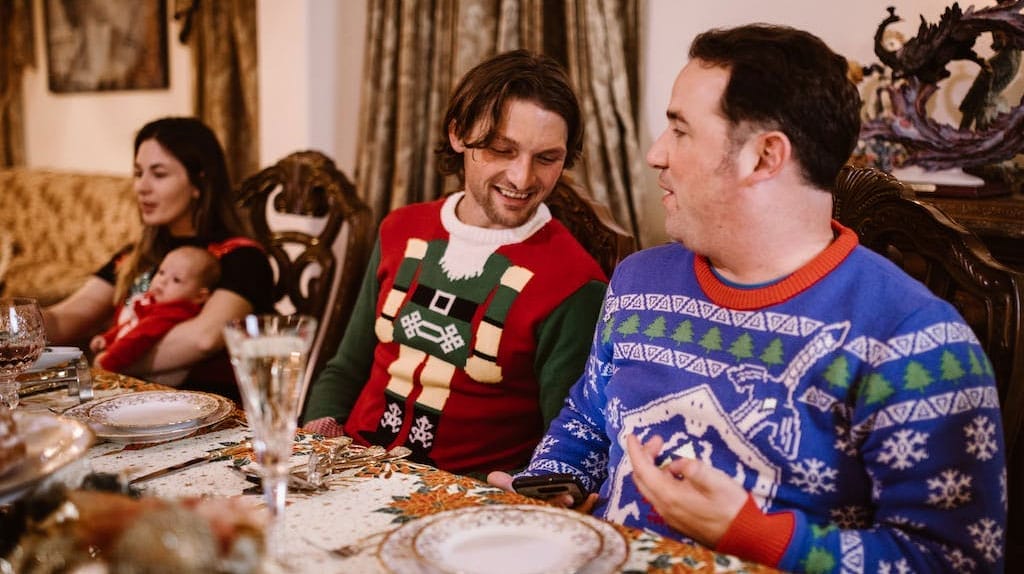
- Santa Claus Outfits The universally recognized Santa Claus, with his plush red suit, white beard, and jolly demeanor, is a symbol of Christmas joy. This iconic attire, complete with a hat, belt, and boots, has its roots in Western Christian culture but has since been embraced globally. The outfit is inspired by Saint Nicholas and further popularized by 19th-century illustrations and advertisements. Today, it’s common to see individuals donning this attire during parades, events, and festive gatherings, spreading cheer and merriment.
- Traditional European Dresses In various parts of Europe, traditional dresses are worn with pride during Christmas celebrations. For instance, in Poland, women might wear colorful vests with floral patterns, while in Sweden, the ‘Lucia Bride’ wears a white gown with a red sash and a crown of candles during the Festival of Lights. These attires, rich in history and cultural significance, add a touch of authenticity to the celebrations.
- Ugly Christmas Sweaters A more recent and playful tradition, the “Ugly Christmas Sweater” parties have gained immense popularity. These sweaters, often adorned with kitschy and over-the-top Christmas-themed graphics, are worn with a sense of humor and camaraderie. It’s a fun way to celebrate the season, often leading to competitions and gatherings centered around showcasing the most outrageous designs.
- La Befana’s Witch Costume In Italy, the legend of La Befana is celebrated with much fervor. La Befana, a kind-hearted witch, is often depicted in a tattered dress with a headscarf, riding a broomstick. On Epiphany’s Eve, many participate in parades and events dressed as La Befana, reenacting the tale and distributing sweets to children.
- Three Kings’ Robes In regions that celebrate Three Kings’ Day or Epiphany, it’s common to see parades where participants dress as the three wise men. These robes, often ornate and colorful, symbolize the regal nature of the kings who traveled to present gifts to baby Jesus.
- Nativity Scene Costumes Many Christian communities reenact the nativity scene, depicting the birth of Jesus. Participants dress as Mary, Joseph, the shepherds, the angels, and the three wise men. These costumes, often simple yet symbolic, play a crucial role in conveying the story’s essence and significance.
- Kallikantzaroi of Greece In Greek folklore, the Kallikantzaroi are mischievous goblins that surface during the 12 days of Christmas. People dress up as these creatures, donning ragged clothes and masks, and participating in events that ward off these sprites and protect households.
- Las Posadas Attires in Mexico Las Posadas, a nine-day celebration in Mexico, involves processions reenacting Mary and Joseph’s search for shelter. Participants often dress in biblical attires, with children sometimes dressed as angels, guiding the way with candles and lanterns.
- Matching Christmas Pajamas: A Family Favorite
- Among the favorite Christmas traditions that have emerged recently is the charming custom of families wearing matching Christmas pajamas. This time of the year becomes even more memorable when families, from the eldest to the youngest, gather in their coordinated outfits. The sight of everyone in their matching Christmas pajamas, sharing stories and moments, truly captures the spirit of the holiday season.
Nature and Outdoor Traditions:
Nature plays a pivotal role in Christmas celebrations, symbolizing rebirth, hope, and the unbreakable bond between humans and the environment. From ancient customs that honor the earth to modern outdoor activities that celebrate the season, nature-centric traditions offer a refreshing perspective on the festive holiday. Let’s explore some of these traditions that beautifully intertwine the spirit of Christmas with the wonders of nature.
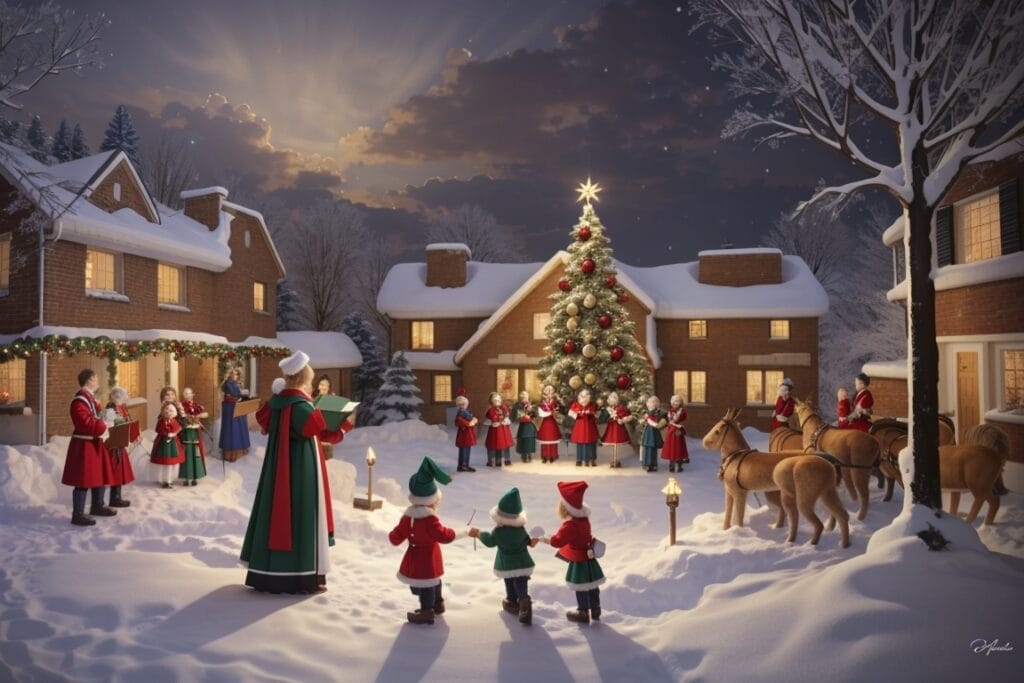
- Evergreens and Their Significance Evergreens, with their enduring vitality even in the harshest winters, have long been symbols of eternal life and hope. Ancient civilizations, including the Romans and Celts, adorned their homes with evergreen boughs during winter solstice celebrations. This custom evolved over time, and today, the Christmas tree, an evergreen fir, stands as a testament to this age-old tradition, representing hope, resilience, and the promise of a new beginning.
- The Yule Log Tradition The burning of the Yule log is a tradition steeped in ancient European pagan rituals. Originally, a whole tree was chosen, and its burning symbolized the return of the sun, warding off evil spirits and bringing good fortune for the coming year. Today, this custom has taken on various forms, including the popular French “Bûche de Noël,” a delicious chocolate cake resembling a log.
- Caroling Under the Stars Caroling, a delightful tradition of singing Christmas hymns, often takes place outdoors. Groups of carolers venture out into the chilly winter night, going from door to door, spreading festive cheer with their melodies. This practice, which began in medieval Europe, not only celebrates the birth of Jesus but also the joy of community and the beauty of nature on crisp winter nights.
- Sleigh Rides and Winter Sports The image of a horse-drawn sleigh gliding through a snow-covered landscape is synonymous with a winter wonderland. Sleigh rides, popularized in songs like “Jingle Bells,” offer a magical experience, allowing people to connect with nature and relish the beauty of winter. Additionally, outdoor activities like ice skating, snowball fights, and building snowmen have become integral to Christmas celebrations in colder regions, emphasizing the joy of playing in nature’s winter playground.
- Mistletoe and Its Mystique Mistletoe, with its bright green leaves and white berries, holds a special place in Christmas lore. Ancient Druids believed it to possess healing powers and used it in winter solstice rituals. Today, the custom of kissing under the mistletoe is a cherished tradition, symbolizing love, friendship, and a promise of good fortune.
- Christmas Markets in Open Squares Originating in medieval Germany, open-air Christmas markets have become a global phenomenon. Set against the backdrop of historic town squares, these markets are a sensory delight, with twinkling lights, aromatic spices, and handcrafted goods. They offer a unique blend of commerce, community, and nature, as people gather under the open sky to celebrate the season. Visit a Christmas market and discover the sights, sounds, and delights of the season.
- Nature-inspired Decorations Nature offers a treasure trove of decoration ideas for Christmas. From pine cones and dried orange slices to holly berries and cinnamon sticks, natural elements bring a touch of rustic charm to festive decor. These eco-friendly decorations not only look beautiful but also serve as a reminder of our deep-rooted connection with the environment.
- Midnight Mass Under the Stars In many cultures, attending a midnight mass on Christmas Eve is a revered tradition. Some communities hold these services outdoors, under the canopy of stars, adding a celestial touch to the spiritual experience. This practice emphasizes the sanctity of nature and the divine, merging the boundaries between the earthly and the ethereal.
Charitable and Giving Traditions:
The spirit of Christmas is not just about receiving, but also about giving, especially to those less fortunate. Charitable acts and traditions during this season remind us of the importance of kindness, compassion, and community. From ancient customs to modern-day initiatives, let’s explore the various charitable traditions that have become synonymous with the essence of Christmas.
- Boxing Day Generosity Originating in Britain, Boxing Day, celebrated on December 26th, has deep charitable roots. Historically, it was the day when alms boxes in churches were opened, and the contents were distributed to the needy. Additionally, employers would give boxes filled with food, money, and other gifts to their servants and employees. This tradition underscores the importance of sharing and caring during the festive season.
- Feast of the Seven Fishes An Italian-American tradition, the Feast of the Seven Fishes, is observed on Christmas Eve. While it primarily revolves around a grand meal, many families incorporate a charitable aspect. They prepare extra portions to share with the less fortunate or donate to organizations that feed the hungry, emphasizing the spirit of sharing during a time of plenty.
- Saint Nicholas Day Giving Before Santa Claus, there was Saint Nicholas, known for his acts of charity. On December 6th, many European countries celebrate Saint Nicholas Day. Children often leave out their shoes, not just to receive treats but also to give. They fill their shoes with carrots and hay for Saint Nicholas’s horse, a gesture that teaches them the joy of giving.
- Christmas Charity Drives Modern times have seen the rise of organized charity drives during the Christmas season. From toy drives like “Toys for Tots” to food drives that ensure everyone has a warm meal on Christmas, these initiatives bring communities together. They serve as a reminder that the festive season is as much about giving back as it is about celebrating.
- The Giving Tree The Giving Tree initiative involves setting up a Christmas tree adorned with tags. Each tag lists a gift requested by someone in need. Participants choose a tag, purchase the gift, and place it under the tree. This heartwarming tradition ensures that even the less fortunate experience the joy of receiving during Christmas.
- Caroling for a Cause While caroling is primarily a musical tradition, many groups turn it into a charitable act. Carolers often collect donations for causes close to their hearts, using their voices to spread both cheer and awareness. This melding of song and charity amplifies the message of love and community.
- Christmas Jumper Day Originating in the UK, Christmas Jumper Day encourages people to don their festive sweaters and donate to charitable causes. This fun and quirky tradition, while light-hearted in nature, carries a profound message of collective generosity.
- Letters to Santa Initiatives Various postal services worldwide have “Letters to Santa” programs. Children write letters to Santa, and charitable individuals or organizations fulfill their wishes. Especially touching are the letters from children in challenging circumstances, making this tradition a beautiful blend of magic and kindness.




